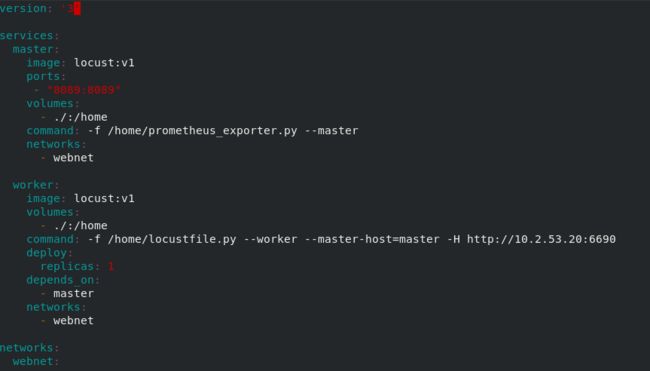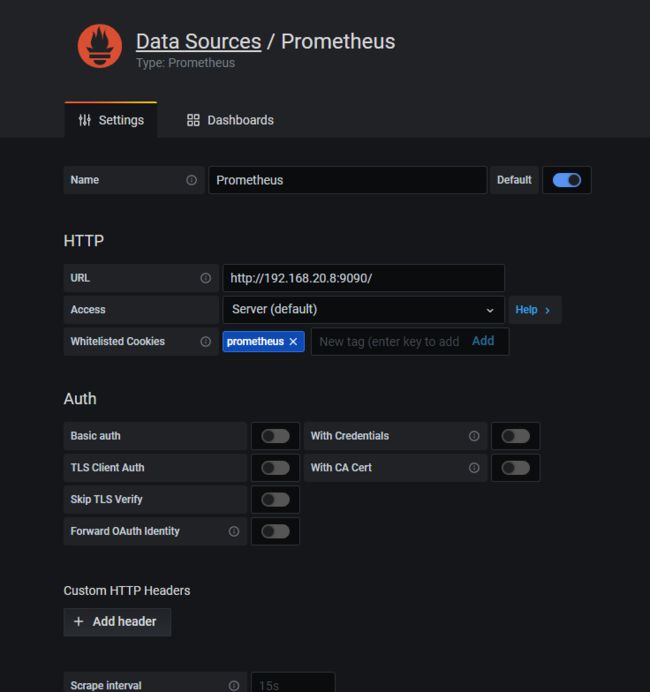docker实现locust+prometheus+grafana性能测试监控
1. Locust + Prometheus + Grafana
简单总结起来就是:实现一个Locust的prometheus的exporter,将数据导入prometheus,然后使用grafana进行数据展示。
2.安装python和docker,整个项目框架如下图所示
commmon可以放置常用的方法,比如获取数据,mysql操作等方法
data放置数据
prometheus_exporter采集locust的性能结果, locust结果的采集在boomer 项目下有一个年久失修的 exporter 实现——prometheus_exporter.py
import six
from itertools import chain
from flask import request, Response
from locust import stats as locust_stats, runners as locust_runners
from locust import User, task, events
from prometheus_client import Metric, REGISTRY, exposition
# This locustfile adds an external web endpoint to the locust master, and makes it serve as a prometheus exporter.
# Runs it as a normal locustfile, then points prometheus to it.
# locust -f prometheus_exporter.py --master
# Lots of code taken from [mbolek's locust_exporter](https://github.com/mbolek/locust_exporter), thx mbolek!
class LocustCollector(object):
registry = REGISTRY
def __init__(self, environment, runner):
self.environment = environment
self.runner = runner
def collect(self):
# collect metrics only when locust runner is hatching or running.
runner = self.runner
if runner and runner.state in (locust_runners.STATE_SPAWNING, locust_runners.STATE_RUNNING):
stats = []
for s in chain(locust_stats.sort_stats(runner.stats.entries), [runner.stats.total]):
stats.append({
"method": s.method,
"name": s.name,
"num_requests": s.num_requests,
"num_failures": s.num_failures,
"avg_response_time": s.avg_response_time,
"min_response_time": s.min_response_time or 0,
"max_response_time": s.max_response_time,
"current_rps": s.current_rps,
"median_response_time": s.median_response_time,
"ninetieth_response_time": s.get_response_time_percentile(0.9),
# only total stats can use current_response_time, so sad.
# "current_response_time_percentile_95": s.get_current_response_time_percentile(0.95),
"avg_content_length": s.avg_content_length,
"current_fail_per_sec": s.current_fail_per_sec
})
# perhaps StatsError.parse_error in e.to_dict only works in python slave, take notices!
errors = [e.to_dict() for e in six.itervalues(runner.stats.errors)]
metric = Metric('locust_user_count', 'Swarmed users', 'gauge')
metric.add_sample('locust_user_count', value=runner.user_count, labels={})
yield metric
metric = Metric('locust_errors', 'Locust requests errors', 'gauge')
for err in errors:
metric.add_sample('locust_errors', value=err['occurrences'],
labels={'path': err['name'], 'method': err['method'],
'error': err['error']})
yield metric
is_distributed = isinstance(runner, locust_runners.MasterRunner)
if is_distributed:
metric = Metric('locust_slave_count', 'Locust number of slaves', 'gauge')
metric.add_sample('locust_slave_count', value=len(runner.clients.values()), labels={})
yield metric
metric = Metric('locust_fail_ratio', 'Locust failure ratio', 'gauge')
metric.add_sample('locust_fail_ratio', value=runner.stats.total.fail_ratio, labels={})
yield metric
metric = Metric('locust_state', 'State of the locust swarm', 'gauge')
metric.add_sample('locust_state', value=1, labels={'state': runner.state})
yield metric
stats_metrics = ['avg_content_length', 'avg_response_time', 'current_rps', 'current_fail_per_sec',
'max_response_time', 'ninetieth_response_time', 'median_response_time',
'min_response_time',
'num_failures', 'num_requests']
for mtr in stats_metrics:
mtype = 'gauge'
if mtr in ['num_requests', 'num_failures']:
mtype = 'counter'
metric = Metric('locust_stats_' + mtr, 'Locust stats ' + mtr, mtype)
for stat in stats:
# Aggregated stat's method label is None, so name it as Aggregated
# locust has changed name Total to Aggregated since 0.12.1
if 'Aggregated' != stat['name']:
metric.add_sample('locust_stats_' + mtr, value=stat[mtr],
labels={'path': stat['name'], 'method': stat['method']})
else:
metric.add_sample('locust_stats_' + mtr, value=stat[mtr],
labels={'path': stat['name'], 'method': 'Aggregated'})
yield metric
@events.init.add_listener
def locust_init(environment, runner, **kwargs):
print("locust init event received")
if environment.web_ui and runner:
@environment.web_ui.app.route("/export/prometheus")
def prometheus_exporter():
registry = REGISTRY
encoder, content_type = exposition.choose_encoder(request.headers.get('Accept'))
if 'name[]' in request.args:
registry = REGISTRY.restricted_registry(request.args.get('name[]'))
body = encoder(registry)
return Response(body, content_type=content_type)
REGISTRY.register(LocustCollector(environment, runner))
class Dummy(User):
@task(2)
def hello(self):
pass
docker-compose 或者swarm管理locust master和work,这里是单机主从配置
locustfile.py为接口测试设计,下为网上的一个demo
from locust import HttpLocust, TaskSet, task, between
class NoSlowQTaskSet(TaskSet):
def on_start(self):
# 登录
data = {"username": "admin", "password": "admin"}
self.client.post("/user/login", json=data)
@task(50)
def getTables(self):
r = self.client.get("/newsql/api/getTablesByAppId?appId=1")
@task(50)
def get_apps(self):
r = self.client.get("/user/api/getApps")
class MyLocust(HttpUser):
task_set = NoSlowQTaskSet
host = "http://localhost:9528"prometheus.yml文件 prometheus配置文件
global:
scrape_interval: 15s
evaluation_interval: 15s
scrape_configs:
- job_name: prometheus
static_configs:
- targets: ['localhost:9090']
labels:
instance: prometheus
- job_name: locust
metrics_path: '/export/prometheus'
static_configs:
- targets: ['192.168.20.8:8089']
labels:
instance: locust3.用docker built构建locust镜像,我这里镜像名为locust:v1,然后执行docker init ,docker stack deploy -c ./docker-compose.yml test (或者执行docker-compose up -d)启动locust matser和work,此时就可以访问locust页面,http://ip:8089,可以进行性能测试
4.访问http://masterip:8089/export/prometheus是否正常,也可以执行性能测试,查看该页面收集数据是否正常
5.安装prometheus和grafana镜像
docker pull prom/prometheus
docker pull grafana/grafana并用下面命令启动两个服务
docker run -d --name prometheus -p 9090:9090 -v $PWD/prometheus.yml:/etc/prometheus/prometheus.yml prom/prometheusdocker run -d --name grafana -p 3000:3000 grafana/grafana启动之后可通过http://ip:9090/查看prometheus是否启动正常
6.网页端访问 localhost:3000 验证部署成功
选择添加 prometheus 数据源
然后再配置模板,导入模板有几种方式,选择一种方式将dashboard模板导入
最后效果展示






